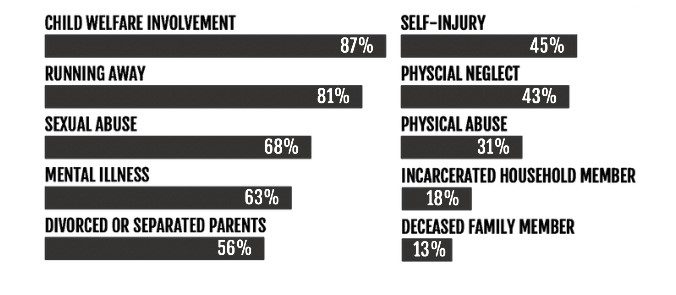12 Facts about Child Sex Trafficking
1. About 4 million children are being trafficked right now.
According to the International Labour Organization in 2017.
2. Trafficking often doesn't involve kidnapping.
Sometimes youth continue going to school, living at home, and participating in extracurricular activities – even while they are being trafficked.
3. Trafficking can look like anyone and don't fit one stereotype.
Love146 has connected with situations of trafficking in which exploiters have been family members, peers, romantic partners, educators, employers, community leaders, and clergy.
4. Child trafficking is happening in every type of community.
Trafficking occurs wherever there are people. If you looked at a map of trafficking referrals, major highways, and human population density, you'd find they are often closely aligned. Where there are more people, more children are likely being exploited. So yes, big cities or along highways could be “hotspots” for child trafficking locations, but more accurately, they're hotspots of human population.
5. The definition of child sex trafficking is the exchange of any sex act with a minor for anything of value.
Child trafficking intersects with a wide range of issues including but not limited to housing insecurity, poverty, and racism. It does not occur in a vacuum. Traffickers prey on a multitude of vulnerabilities in order to exploit children. Therefore, in order to realize the end of child trafficking and exploitation we must acknowledge and devote effort to the issues that impact and intersect with child trafficking.
6. Unfortunately, many U.S. states still don't have laws that protect exploited children from being prosecuted for prostitution.
Under U.S. federal law, all children involved in commercial sex are victims of human trafficking. The term “child prostitute” is a misnomer. In many places age of consent and safe harbor laws (which vary state by state in the U.S.) reinforce that these children are not prostitutes but victims.
7. Trafficking is rarely the first thing to go wrong for a child.
Here are things young people in Love146's Survivor Care experienced prior to being referred for help:

8. Sex trafficking is affecting children of all genders.
While it's often thought about as a “women and girls issues,” about 15% of those in Love146's US Survivor Care have been boys and non-binary youth. Stigma is a barrier for boys, men, and nonbinary victims accessing support.
9. Children from culturally and linguistically diverse backgrounds are more than 2x more likely to be exploited.
In a JAMA article analyzing studies from the United States, Canada, and Sweden, it was found this fact, as children who identified as white.
10. LGBTQ+ youth are disproportionately harmed by trafficking.
Certain situations in a child's life can either protect them, or put them at increased risk of trafficking and exploitation. Some things that add vulnerability include bullying, rejection, and stigma. Some things that help protect include acceptance, physical and psychological safety, and supportive family and mentors. Too often LGBTQ+ youth experience these things that put them at risk of trafficking, and don't experience protections. We need to do better changing this equation for LGBTQ+ youth.
11. Often, a “rescue” isn't the only (or best) way to freedom.
Training to recognize & respond appropriately to trafficking, as well as trauma-informed spaces to heal help create pathways for more victims to exit exploitation. Many children in Love146's Survivor Care haven't been physically removed by law-enforcement from their exploitation. Rather, they're connected to Love146 or child welfare agencies by caring adults who notice something is wrong – or sometimes even reaching out themselves and asking for help.
12. Myth: there's nothing you can do to end child trafficking.
The truth is that child trafficking will end when enough of us refuse to tolerate it.
You can help by:
- Learning about the issue from credible sources and helping to combat misinformation.
- Being a safe, nonjudgmental person, and a listening ear for youth in your life.
- Getting involved and supporting trustworthy anti-trafficking organizations.
Want to share this facts with your network? Find graphics on our social media toolkit here.
This “Eyes on Trafficking” story is reprinted from its original online location.
 ABOUT PBJ LEARNING
ABOUT PBJ LEARNING
PBJ Learning is a leading provider of online human trafficking training, focusing on awareness and prevention education. Their interactive Human Trafficking Essentials online course is used worldwide to educate professionals and individuals how to recognize human trafficking and how to respond to potential victims. Learn on any web browser (even your mobile phone) at any time.
More stories like this can be found in your PBJ Learning Knowledge Vault.
EYES ON TRAFFICKING
This “Eyes on Trafficking” story is reprinted from its original online location.
ABOUT PBJ LEARNING
PBJ Learning is a leading provider of online human trafficking training, focusing on awareness and prevention education. Their interactive Human Trafficking Essentials online course is used worldwide to educate professionals and individuals how to recognize human trafficking and how to respond to potential victims. Learn on any web browser (even your mobile phone) at any time.
More stories like this can be found in your PBJ Learning Knowledge Vault.
